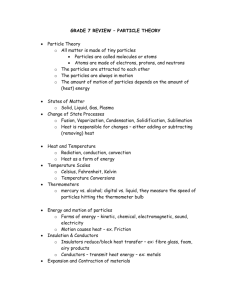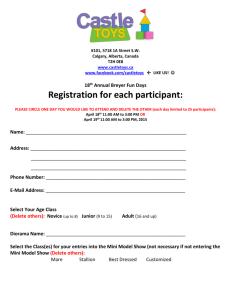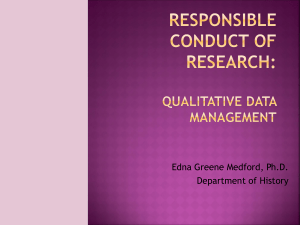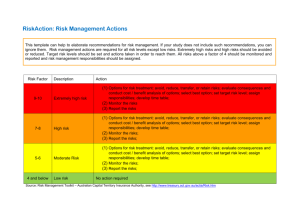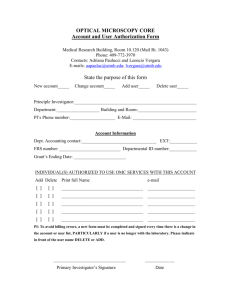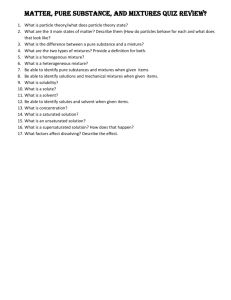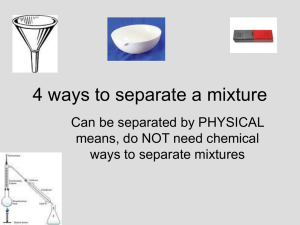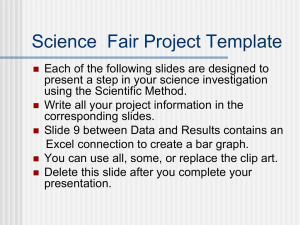Grade 7 Science
advertisement
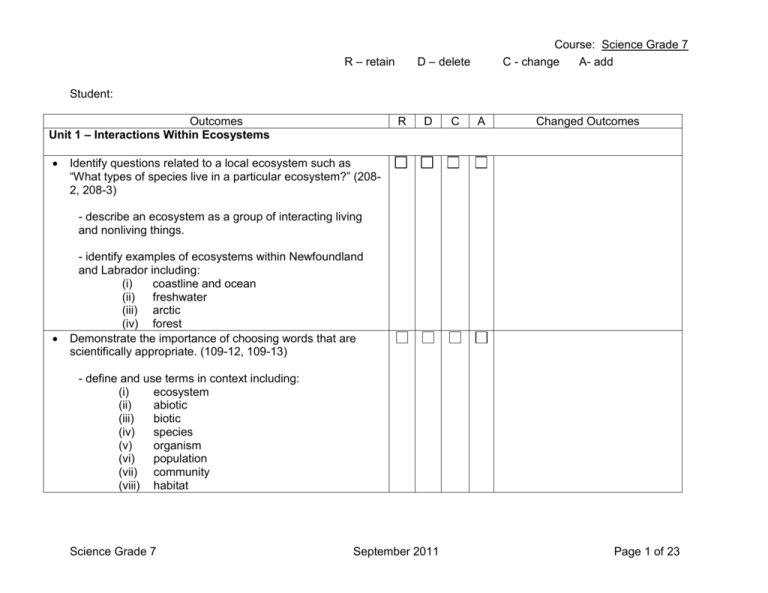
R – retain Course: Science Grade 7 C - change A- add D – delete Student: Outcomes Unit 1 – Interactions Within Ecosystems R D C A Changed Outcomes Identify questions related to a local ecosystem such as “What types of species live in a particular ecosystem?” (2082, 208-3) - describe an ecosystem as a group of interacting living and nonliving things. - identify examples of ecosystems within Newfoundland and Labrador including: (i) coastline and ocean (ii) freshwater (iii) arctic (iv) forest Demonstrate the importance of choosing words that are scientifically appropriate. (109-12, 109-13) - define and use terms in context including: (i) ecosystem (ii) abiotic (iii) biotic (iv) species (v) organism (vi) population (vii) community (viii) habitat Science Grade 7 September 2011 Page 1 of 23 R – retain Outcomes (ix) niche Investigate the biotic and abiotic factors of a local ecosystem. (306.3) Course: Science Grade 7 C - change A- add D – delete R D C A Changed Outcomes - define range of tolerance - describe the following abiotic factors of local ecosystems. (i) intensity of sunlight (ii) air, soil and water temperature (iii) wind direction and speed Define and delimit questions to investigate in a local ecosystem. (208-3) Organize and record information collected in an investigation of an ecosystem using instruments effectively and accurately. (209-3, 209-4) Communicate questions, ideas, plans, and results, using lists, notes in point form, sentences, oral language, and other means. (211-2) Work cooperatively with team members to develop and carry out a plan, and troubleshoot problems as they arise(211-3) Evaluate individual and group processes used in planning, decision making, and completing a task (211-4) Use a key to identify the biotic factors observed in the local ecosystem (210-1) Describe interactions between biotic and abiotic factors in an ecosystem, (306-3) including: (i) biotic-abiotic (ii) abiotic-abiotic (iii) biotic-biotic Science Grade 7 September 2011 Page 2 of 23 R – retain Outcomes Investigate an interaction between a biotic and an abiotic factor in an ecosystem (306-3) Design and carry out an experiment controlling major variables (208-6, 209-1) Organize, compile and display data using tables (209-4, 2102) Defend a given position on an issue or problem based on their findings (211-5) Identify the niche of producers, consumers, and decomposers in a local ecosystem (304-2) Course: Science Grade 7 C - change A- add D – delete R D C A Changed Outcomes - Define and use in context the terms producer, consumer and decomposer. - Define herbivores, carnivores and omnivores in terms of different types of consumers Given a diverse group of organisms, classify them as producers, consumers, or decomposers. (304-1) Describe how energy is supplied to, and how it flows through, a food chain (306-1) - recognize that producers use light energy, carbon dioxide, and water (photosynthesis) to produce energy for the ecosystem. - define food chain - construct simple food chains using local examples - classify the organisms within food chains as producers, Science Grade 7 September 2011 Page 3 of 23 R – retain Outcomes herbivores, carnivores and omnivores Apply the concept of a food web as a tool for interpreting the structure and interactions of an ecosystem. (111-6) Course: Science Grade 7 C - change A- add D – delete R D C A Changed Outcomes - define food web - interpret food webs using organisms from local ecosystems Describe how energy flows through a food chain and a food web. (306-1) - recognize how energy flows through food chains and food webs from producers to herbivores to carnivores/omnivores as well as to decomposers. Describe how matter is recycled in an ecosystem through interactions among plants, animals, fungi and microorganisms. (306-2) - illustrate and explain the nutrient cycle. Identify changes that have occurred in a local ecosystem over time. (306-4) - define succession Construct a flow chart of images to illustrate the changes that will take place in an ecosystem based on the characteristics of the area, (208-5, 210-2) including: (i) bare rock to forest (primary succession) (ii) forest re-growth after fire (secondary succession) Science Grade 7 September 2011 Page 4 of 23 R – retain Outcomes Course: Science Grade 7 C - change A- add D – delete R D C A Changed Outcomes - recognize that as succession occurs in an area, the ecosystem of the area will also change. Describe how our need for a continuous supply of wood resulted in the development of silvaculture practice. (112-3) Make informed decisions about forest harvesting techniques taking into account the environmental advantages and disadvantages. (113-9) Provide examples of how our understanding of boreal forest ecology has influenced our harvesting practices identifying the positive effects of these practices. (111-1, 113-1) Identify various science- and technology-based careers related to forest management and harvesting. (112-0) Defend a course of action to protect the local habitat of a particular organism. (113-11) - Recognize that humans have influenced the natural environment including: (i) habitat loss/destruction (ii) harvesting resources (iii) pollution (iv) introduced species - Discuss the pros and cons of habitat conservation. Pros (i) sustainability of resource (ii) preservation of biodiversity (iii) eco-tourism Science Grade 7 September 2011 Page 5 of 23 R – retain Outcomes Cons (i) artificial habitats (ii) economic loss (job loss, etc.) (iii) limited human use Recognize that a variety of groups and individuals are interested in protecting the environment. (112-4, 112-8) Unit 2 - Heat Relate personal activities in formal and informal settings to temperature. (109-10) Course: Science Grade 7 C - change A- add D – delete R D C A Changed Outcomes - define temperature operationally. - relate temperature to everyday experiences, including: (i) daily temperature changes (ii) cooking temperatures (iii) refrigeration temperatures (iv) average temperatures in different geographic areas - predict and identify the temperature of various familiar objects including: (i) human body temperature (ii) temperatures of boiling and freezing water (iii) comfortable room temperature Provide examples of temperature measuring technologies used in the past, (110-7) including: (i) Galileo’s air thermometer (ii) early liquid thermometers Science Grade 7 September 2011 Page 6 of 23 R – retain Outcomes - identify scales used in temperature measurement including: (i) Celsius (ii) Fahrenheit (iii) Kelvin Select appropriate methods and tools in order to construct and test a thermometer (208-8, 210-13) Compile and display data collected in the test of the design of the constructed thermometer (210-2) Describe various instruments used to measure temperature, (308-1) including: (i) liquid-in-glass thermometer (ii) thermocouple (iii) resistance thermometer (iv) bimetallic strip (thermostat) (v) infrared thermometer Define temperature using the particle theory of matter. (3082) Course: Science Grade 7 C - change A- add D – delete R D C A Changed Outcomes - define matter - describe the particle theory of matter, including: (i) All matter is made up of tiny particles (ii) These particles are always moving – they have energy. The more energy the particles have, the faster they move. (iii) There is space between all particles. (iv) There are attractive forces between the particles Science Grade 7 September 2011 Page 7 of 23 R – retain (v) Outcomes The particles of one substance differ from the particles of other substances Course: Science Grade 7 C - change A- add D – delete R D C A Changed Outcomes - define kinetic energy as the energy that particles have due to motion - define temperature as a measure of the average kinetic energy of the particles of a substance Explain how each state of matter reacts to changes in temperature. (308-3) - describe and compare the three states of matter using the particle theory of matter in terms of: (i) volume (ii) shape (iii) arrangement of particles (iv) movement of particles - define expansion and contraction - use the particle theory of matter to explain expansion and contraction in the three states of matter. Explain changes of state using the particle theory of matter, (308-4) including: (i) melting (ii) freezing (iii) evaporation State a hypothesis, carry out an experiment, identify and control major variables and state a conclusion based on Science Grade 7 September 2011 Page 8 of 23 R – retain Outcomes experimental data (208-6, 210-11) Use heating and measuring tools accurately and safely (2096) Organize, compile and display data using tables and graphs (209-4, 210-2) Compare transmission of heat by conduction, convection, and radiation. (308-5) Course: Science Grade 7 C - change A- add D – delete R D C A Changed Outcomes - define conduction, convection and radiation in terms of: (i) particle movement (ii) state(s) in which it occurs - list common examples of the three processes of heat transfer, including: (i) conduction – cookware, ice pack (ii) convection – air currents, heating a liquid (iii) radiation – fireplace, sunlight Describe how various surfaces absorb radiant heat (308-6) Design and conduct an experiment to test identified questions, state a hypothesis, identify and control major variables. (208-3, 208-5, 209-1) Use experimental apparatus and tools safely. (209-6) Organize and display data using tables and graphs. (209-4, 210-2) State a conclusion, based on experimental data, and explains how evidence gathered supports or refutes an initial idea. Science Grade 7 September 2011 Page 9 of 23 R – retain Outcomes Provide examples of heat technologies used past and present to heat homes in Newfoundland and Labrador (1107), including: (i) wood stove (ii) electric heat (iii) oil furnace (iv) air to air heat pump (v) hot water radiation (vi) geothermal (vii) solar Identify different approaches taken to solve the problem of heating homes during cold times of the year. (109-7) Make an informed decision about the various technologies used to heat our homes, taking into account potential advantages and disadvantages. (110-7, 113-8) Provide examples of how our understanding of evaporation and condensation of liquids resulted in the development of heat pumps. (111-1) Provide examples of insulating technologies used today and in the past (109-4), including: (i) animal fur (ii) sod (iii) fiberglass (iv) thermos Course: Science Grade 7 C - change A- add D – delete R D C A Changed Outcomes - distinguish between thermal conductors and insulators. Compare, in qualitative terms, the specific heat capacities of some common materials. (308-7) Science Grade 7 September 2011 Page 10 of 23 R – retain Outcomes - distinguish between heat and temperature. Course: Science Grade 7 C - change A- add D – delete R D C A Changed Outcomes - define specific heat capacity. - compare the specific heat capacity of the following substances: (i) water (ii) alcohol (iii) soil (dry) (iv) steel (v) wool Describe how our needs related to heat can lead to developments in science and technology. (112-1) Identify examples of science- and technology-based careers that are associated with heat and temperature. (112-9) Unit 3 – Mixtures and Solutions Distinguish between pure substances and mixtures using the particle theory of matter. (307-1) - define the particle theory of matter. - using observations, categorize substances as pure or mixtures. - define the terms pure substance and mixture using the particle theory of matter. - identify examples of various pure substances, including: (i) distilled water (H20) Science Grade 7 September 2011 Page 11 of 23 R – retain (ii) (iii) (iv) (v) Outcomes sugar (C12H22O11) copper (Cu) oxygen (O2) carbon dioxide (CO2) Course: Science Grade 7 C - change A- add D – delete R D C A Changed Outcomes - identify examples of various mixtures that are found in or around student homes, including: (i) salad dressing (ii) chocolate chip cookie (iii) Kool-aid (iv) concrete (v) air Distinguish between heterogeneous (mechanical) and homogeneous (solution) mixtures using the particle theory of matter. (307-3) - identify that homogeneous mixtures appear as one substance and light will pass through unaffected. - identify that heterogeneous mixtures may appear as more than one substance and light will scatter as it passes through. - identify some mixtures as combinations of heterogeneous and homogeneous mixtures, including: (i) orange juice (ii) milk (iii) soft drink Describe dissolving as a characteristic of solutions using the particle theory of matter. (307-3) Science Grade 7 September 2011 Page 12 of 23 R – retain Outcomes - define: (i) (ii) (iii) (iv) Course: Science Grade 7 C - change A- add D – delete R D C A Changed Outcomes dissolving solute solvent solubility (soluble/insoluble) - identify that solutions can form between the three states of matter, including: (i) solid solute – liquid solvent (ii) gas solute – liquid solvent (iii) gas solute – gas solvent (iv) solid solute – solid solvent (v) liquid solute – liquid solvent - given an example of a solution and its components, identify the solute and solvent Describe the concentrations of solutions qualitatively and quantitatively. (307-4) - define: (i) (ii) (iii) concentrated dilute concentration - distinguish between concentrated and dilute solutions - describe the concentration of solutions qualitatively using the terms: (iv) saturated Science Grade 7 September 2011 Page 13 of 23 R – retain (v) (vi) (vii) Outcomes unsaturated dilute concentrated Course: Science Grade 7 C - change A- add D – delete R D C A Changed Outcomes - describe the concentrations of solutions quantitatively as the amount of solute per unit volume, including: (i) g/L (ii) percentage by mass (iii) ppm (parts per million) State a hypothesis based on background information or an observed pattern of events. (208-5) Identify and delimit questions and problems to facilitate investigation. (208-2, 208-3) Identify the line of best fit and interpolate or extrapolate based on the line of best fit. (210-5) Develop a testable hypothesis on the effect of temperature on solubility. (208-1) Carry out procedures controlling the major variables to study the effect of temperature on solubility. (209-1) Describe qualitatively the factors that affect the solubility of a solid and a gas (307-5), including: (i) temperature (ii) pressure Using apparatus safely, identify and separate the components of a variety of mixtures. (209-6, 307-2) - describe how to use different methods to separate a variety of mixtures, including: (i) mechanical sorting (flotation, magnetism) Science Grade 7 September 2011 Page 14 of 23 R – retain Outcomes (ii) filtration (iii) evaporation (iv) distillation (v) paper chromatography Identify common separation techniques used to separate the components of a variety of mixture (209-6, 307-2), including: (i) straining spaghetti in colander (ii) skimming fat off soup (iii) drying clothes (separating water from fabric) (iv) window screens allowing air in while keeping insects out (v) making coffee using ground coffee beans Course: Science Grade 7 C - change A- add D – delete R D C A Changed Outcomes - choose an appropriate separation technique when given a known mixture where students know the identity of the components. Describe the science underlying a distillation apparatus, using the following terms: boiling, evaporation, condensation. (115-5) - define distillation - explain how a distillation apparatus is used to separate a solution - describe where boiling, evaporation and condensation occurs in a distillation apparatus Carry out procedures controlling the major variables to answer questions arising from practical problems (208-2, Science Grade 7 September 2011 Page 15 of 23 R – retain Outcomes 209-1) Use tools and instruments safely and accurately when carrying out procedures and collecting data (209-3, 209-6) Answer new questions that result from the mixture separation activities. (210-16) Using distillation as an example, show how refining and separation techniques have evolved (109-4), including: (i) simple distillation (ii) fractional distillation Provide examples of how science related to mixtures and solutions affect our lives. (112-7) Identify some positive and negative effects and intended and unintended consequences of using salt on highways. (113-1) Describe how our understanding of the properties of solutions has resulted in better road de-icing technologies. (111-1) Make an informed decision about the use of road salt as our main road de-icing chemical taking into account the environmental, social, and economic advantages and disadvantages. (113-9) Unit 4 – Earth’s Crust Classify minerals based on their physical properties. (210-1, 310-2) Course: Science Grade 7 C - change A- add D – delete R D C A Changed Outcomes - define mineral - list and describe properties of minerals, including: (i) colour (ii) streak Science Grade 7 September 2011 Page 16 of 23 R – retain Outcomes (iii) lustre (iv) hardness (v) cleavage (vi) fracture Use a mineral classification key to investigate questions arising from practical problems (208-2, 210-1) Select appropriate methods and tools for collecting and organizing data to identify minerals (208-8, 209-4) Using a classification key, identify common minerals (210-1), including: (i) quartz (ii) calcite (iii) magnetite (iv) mica (v) pyrite (vi) galena (vii) gypsum (viii) talc (ix) feldspar (x) hematite Classify rocks based on their characteristics and method of formation. (310-2) Course: Science Grade 7 C - change A- add D – delete R D C A Changed Outcomes - define rock - define igneous rock and describe their formation - differentiate between magma and lava Science Grade 7 September 2011 Page 17 of 23 R – retain Outcomes - differentiate between intrusive and extrusive igneous rocks using examples, including: (i) granite (intrusive) – magma (ii) basalt (extrusive) – lava Course: Science Grade 7 C - change A- add D – delete R D C A Changed Outcomes - define sedimentary rock - list and show examples of sedimentary rocks, including: (i) shale (small particles) (ii) sandstone (medium particles) (iii) conglomerate (large particles) (iv) limestone (plant and animal particles) - define metamorphic rock - describe the formation of metamorphic rocks - list examples of metamorphic rocks and their parent rock, including: (i) slate from shale (ii) marble from limestone (iii) quartzite from sandstone (iv) gneiss from granite Identify questions to investigate arising from the study of the rock cycle. (208-2) - sketch and label a diagram of the rock cycle. - recognize the relationship between various types of rocks (igneous, sedimentary, metamorphic) Science Grade 7 September 2011 Page 18 of 23 R – retain Outcomes Describe the characteristics of Earth’s crust and some of the technologies which have allowed scientists to study geological features in and on the earth’s crust. (109-7, 1112, 310-1) Course: Science Grade 7 C - change A- add D – delete R D C A Changed Outcomes - sketch and label a model of Earth’s layered interior, including: (i) inner core (ii) outer core (iii) mantle (iv) crust - describe the composition of each layer - recognize that Earth’s crust is broken into plates and movement occurs where plate margins meet (plate tectonics). Describe how plate tectonic theory has evolved in light of new geological evidence. (110-4) - identify Alfred Wegener as the person responsible for proposing the continental drift theory. - describe the continental drift theory and the evidence supporting it, including evidence from: (i) continental fit (paleogeographic) (ii) fossils (biological) (iii) rock layers (geological) (iv) climate (meteorological) Science Grade 7 September 2011 Page 19 of 23 R – retain Outcomes - identify the technological advances that have provided evidence to support the current theory of plate tectonics, including: (i) sonar (ii) magnetometers (iii) deep sea drilling Course: Science Grade 7 C - change A- add D – delete R D C A Changed Outcomes - identify types of plate boundaries, including: (i) divergent (pulling apart) (ii) convergent (pushing together) (iii) transform (sliding past) - identify convection currents in the Earth as the driving force mechanism behind plate tectonics Provide examples of Canadian contributions to our understanding of local, regional, and global geology. (11212) Describe how our explanations of how the Earth has changed over time are based on the collection of evidence and finding relationships between various observations in imaginative ways. (109-2) Describe how our understanding of the forces that shaped our Earth has changed over time as new evidence was collected. (110-5) Identify the theory of continental drift as one early explanation for how our Earth changed over time. (110-1) Identify the theory of plate tectonics as an example of a major shift in our world view. (110-3) Examine some of the catastrophic events that occur on or Science Grade 7 September 2011 Page 20 of 23 R – retain Outcomes near the Earth’s surface (311-4), including: (i) earthquakes (ii) volcanic eruptions Course: Science Grade 7 C - change A- add D – delete R D C A Changed Outcomes - define earthquake - explain why earthquakes occur using the concept of plate tectonics, - define volcano - identify how and where volcanoes form. Include: (i) areas where plates converge (ii) areas where plates diverge (iii) areas where plates are thin (hot spots) Organize and analyze data on the geographical distribution of earthquakes and volcanoes to determine patterns and trends. (209-4, 210-6, 311-5) Provide examples of theories used in the past to explain volcanic activity, earthquakes, and mountain building. (1101) - identify explanations of volcanic and earthquake activity from the past, including: (i) Pele (ii) Glooscap Explain the processes of mountain formation (311-1) - define folding and faulting Science Grade 7 September 2011 Page 21 of 23 R – retain Outcomes - explain how mountains are formed using the theory of plate tectonics including: (i) folding (ii) faulting (iii) volcanic eruption Develop a chronological model or geological time scale of major events in Earth’s history. (209-4, 311-6) Course: Science Grade 7 C - change A- add D – delete R D C A Changed Outcomes - describe the geologic time scale in terms of the four main eras and the major events that occurred in each, including: (i) Precambrian – formation of the Earth and appearance of simple life forms (ii) Paleozoic – appearance of more complex life forms (iii) Mesozoic – appearance and extinction of dinosaurs (iv) Cenozoic – appearance of humans Explain various ways in which rocks can be weathered and eroded to form soils. (311-2) - define weathering - identify types of weathering including: (i) mechanical (ii) chemical - define erosion - identify the various agents of erosion including: (i) water in motion Science Grade 7 September 2011 Page 22 of 23 R – retain (ii) (iii) Outcomes meteorological processes (rain and wind) geological processes (gravity and glaciers) Course: Science Grade 7 C - change A- add D – delete R D C A Changed Outcomes - differentiate between weathering and erosion Classify various types of soil according to their characteristics (310-3), including: (i) coarse-textured (sandy/gravel) soil (ii) medium-textured (loamy) soil (iii) fine-textured (clay) soil - define porosity and permeability - relate porosity and permeability to soil types Carry out procedures controlling the major variables to answer questions arising from practical issues. (208-2, 2091) Use instruments effectively and accurately for collecting data. (209-3) Compile, organize and display data using a tabular format. (209-4, 210-2, 211-2) Interpret patterns and trends in data, and infer and explain relationships among the variables. (210-6) State a conclusion, based on experimental data, and explain how the data gathered supports or refutes an initial idea. (210-11) Science Grade 7 September 2011 Page 23 of 23
